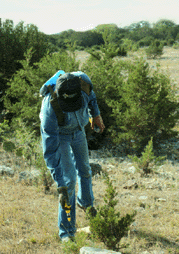Cedar Soil Spot Spray Method
Works Best:
On blueberry or redberry cedars less than 3 feet tall.
When to Apply:
Late winter to mid-spring (ideally, before expected rainfall).
1. Prepare Equipment
Soil spot sprays should be applied with an exact delivery handgun. This equipment is available from most herbicide retail outlets. The handgun delivers a thin stream of predetermined volume when triggered. Adjust the handgun to deliver 2 ml (cc) for each pull of the trigger. If only a few plants are to be treated, a disposable syringe can be used. All spray equipment should be thoroughly cleaned immediately after use.
2. Prepare Herbicide
Velpar L™ is the recommended herbicide for soil spot sprays to control cedar. The herbicide is used undiluted, by attaching an exact delivery handgun or syringe to the herbicide container.
3. Apply the Herbicide
Apply undiluted Velpar L™ to the soil surface midway between the cedar stem and the canopy edge. Apply 2 ml for every 3 feet of plant height or every 3 feet of plant canopy diameter (whichever is greater). If plant size requires more than a single 2-ml application, space applications equally around the plant. Apply each 2-ml dose to a single spot on the soil surface. On slopes, apply most of the herbicide on the uphill side of the stem.
Keep these points in mind:
- Follow herbicide label directions.
- Do not use on marshy or poorly drained sites.
- Do not use on clay soils.
- Do not apply to snow-covered or frozen ground.
- Do not apply within three times the height or canopy diameter (whichever is greater) of desirable trees such as oaks or pecans.
- Rainfall is required to “activate” Velpar L™ in the soil. Plants will begin to show symptoms within 3 to 6 weeks of initial rainfall. One to three growing seasons may be required before plants die, and during this time cedars usually sprout new leaves several times.
- Grasses and weeds will be killed where each spot of Velpar L™ is applied. Recovery may take 2 to 3 years.
- Cost of treatment escalates rapidly as density and size of cedar increases